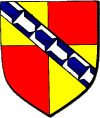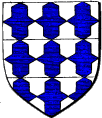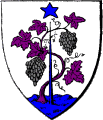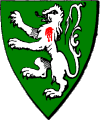

Apres li vi-je tout premier Ke ben sa baniere rewarde
Le vaillant Robert de la Warde Vairie est de blanc e de noir.
De menu-vair de cinq tires, au chevron de gueules--STESSIN, Flanders.
Plein de menu-vair--BANVILLE DE TRUTEMNE, Normandie.
De beffroi, d'or et d'azur--D'AUBETERRE, Champagne.
 |
| Le Conte de FERRERS. |
 |
| BEAUCHAMP. |
Le Conte de FERRERS, verree de or et de goules--Roll, temp. HEN. III.
Hugh de FERRERS, vairre de argent et d'azur--Ibid.
Robert de BEAUCHAMP, de vairrie--Ibid.
Piers de MAULEE, de veirre a la manche de goules--Ibid.
Sire Hugh de MEYNI, verre de argent e de sable, e un label de goules--Roll, temp. ED. II.
Monsire John de BEAUCHAMP de Somersetshire, port de verre--Roll, temp. ED. III.
Monsire de NOWERS, port verre d'argent et de gules--Ibid.
Monsire La WARD, port verre d'argent et sable--Roll, temp. ED. III.
Vairy argent and azure--BEAUCHAMP.
Vairy argent and gules--GRESLEY, Norfolk.
Vairy argent and sable--MAYNELL.
Vairé, ermine and gules--GRESLEY, Derbyshire.
 |
| SACKVILLE. |
 |
| ATTERBURY. |
Or, [another gules], a saltire vair--WILLINGTON of Umberleigh, co. Devon, and Hurley, co. Warwick.
Sire Johan de HOORNE, de goules a une frette de veer--Roll, temp. ED. II.
Quarterly, or and gules, a bend vair--SACKVILLE.
Paly of six or and gules; a chief vair--Francis ATTERBURY, Bp. of Rochester, 1713-23.
Argent, a bend sable and chief vair--Michael de NORTHBURG, Bp. of London, 1461-66.
Barry of six, vaire gules, and ermine, and azure--Gules de BRAOSE, Bp. of Hereford, 1200-16.
Sire Adam de EVERINGHAM, de goules, a un lion rampaund de veer--Roll, temp. ED. II.
 |
| Counter vair. |
Counter-vary or and gules--BROTIER.
De contre-vair; au franc canton d'hermine--SALPERWICK, Artois.
Vairé contrevairé d'or et d'azur--TRAINEL, Ile de France.
 |
| Vair en pointe. |
Vairy en point argent and azure--DURANT.Heraldic writers also speak of varry as meaning one of the pieces of which the vair is composed; they also used the terms vairy cuppy and vairy tassy for potent counter potent, perhaps from the drawings in some instances resembling cups, and that in the possible meaning of tassa. It may be said that all these variations of the ancient vair arise from mere accident(generally bad drawing), supplemented by over refinement on the part of the heraldic writers who have described them.
Vairy en point gules and argent--MONKHOUSE.
Vairy argent, azure, gules, and or en point--Roger HOLTHOUSE.
 |
| ARMSTRONG. |
Gules, three dexter arms vambraced argent, hands proper--ARMSTRONG.Vamplet: of a Spear, q.v.
Azure, a fesse embattled ermine between two dexter arms vambraced argent, garnished or--FRANKE, co. Leicester; granted 1689.
Azure, a dexter arm vambraced grasping a sword erect in pale proper, hilted and pomelled or, between three boar's heads couped of the third, langued gules--GORDON, co. Banff.
 |
| Weather-cock. |
Gules, on a saltire argent, between four weather-cocks(the supporters and vanes of the second, the cross crosslets or) five martlets of the field--Arms ascribed to Henry FITZ-ALWYN, first Mayor of London, and Roger FITZ-ALWYN, his successor.2. A Winnowing basket. See Basket.
Per fesse sable and azure, a castle with four towers, the gate displayed argent; on each tower a vane or--RAWSON.
Gules, a castle with two towers or, embattled and masoned sable, adorned with four vanes argent--CHASTELANI, France. [De gueules, au chateau à deux tours d'or moconné de sable--CASTELLANI, Provence.]
D'azur, à un château sommé, de trois tours, pavillonnées et girouettées d'argent, le tout maçonné de sable--CHASTELAIN DE SERTINES.
Azure, two lions passant gardant; the verge of the escutcheon charged with demi-fleurs-de-lis or--Augmentation granted to Katharine HOWARD, fifth wife of Henry VIII.Vergette, (fr.): the diminutive of the pale and vergettée=paly.
 |
| Vert. |
 , a leek.
, a leek. |
| DE LESSEPS. |
Argent, a vine growing out of the base leaved and fructed between two popinjays endorsed, feeding upon a cluster of grapes all proper--WINCHESTER, Scotland.Violet, (fr. violette): is found in one English example.
Argent, a vine with leaves and fruit proper, over all on a bend sable three escallops of the first--LEVINZ, co. Northampton.
Gules, a man's arm couped and embowed, the hand holding a branch of vine fructed, leaved and slipped all proper--CORNEILLES.
Or, three vine leaves vert--ARABIN.
Argent, a chevron between three bunches of grapes proper--BRADWAY, co. Gloucester.
Argent, a bear's head proper holding a bunch of grapes in its mouth between three torteaux; a chief gules--BEARSLEY, Coventry; granted 1730.
D'argent, à un cep de vigne de sinople[entortillé autour d'un echalas du même et] fruité de deux grappes de sable planté sur une terrasse du même mouvante de la pointe de l'écu, et surmonté d'une etoile d'azur--De LESSEPS, Bayonne.
D'argent, au cep de vigne, pampré et terrassé de sinople, fruité de gueules, soutenu d'un échalas de sable--GUYON, Normandie.
De sable, au cep de vigne, chargé de ses pampres, et soutenu d'un échalas de sable--LA TREICHE, Normandie.
De gueules, au pampre d'or feuillé de sinople--Ville de DIJON.
D'or, au chevron de gueules accompagné de trois raisins d'azur--OLIER-NOINTEL.
Argent, a chevron sable fretty or between three violets purpure stalked and leaved vert--DIKENS.Violin: the violin or fiddle is found named in a few coats of arms. It should be drawn with the handle downwards.
D'argent, a trois violettes au naturel, tigées de sable, et un chef d'azur, chargé d'une molette d'éperon d'or a huit pointes--POL, Comtat Venaissin.
Gules, three treble violins transposed argent, stringed sable--SWEETING, Somerset.Viper. See Adder.
Azure, three violins transposed two and one argent, stringed sable--SUTTIE, Inveresk, Scotland.
Azure, three fiddles argent--SUETING.
D'azur, à trois vires d'argent--GLATIGNY, Normandie.Virgin: a figure of a saint, when the name is not known, may be thus blazoned, but usually only the head, or the upper portion, is shewn, and the term demi-virgin is used, as in the insignia of the MERCERS' Company. (See under Eastern Crown.) Similar figures are sometimes blazoned maidens' heads: and those in the insignia of the See of OXFORD, being veiled, are blazoned nuns' heads(sometimes ladies' heads). See under Head.
Vert, a demi-virgin couped at the waist proper, mantled gules turned down ermine, her hair dishevelled, on her head an Eastern crown or--Company of PINMAKERS[Inc. 1636].Virgin Mary: the figure of the Blessed Virgin Mary occurs in the insignia of one or two Sees(that of LINCOLN has already been given, see Nimbus), and of several religious foundations, and of one or two Scotch Burghs; also on those ascribed to a King of England of the tenth century. It will be seen that the Virgin is variously represented, but always with the infant Saviour.
Azure, our Lady the Virgin Mary with a circle of glory over her head, holding in her dexter arm the infant Jesus, head radiant; in the sinister a sceptre all or--See of SALISBURY.Virols: the rings which commonly encircle Bugle-horns, (q.v.); and hence virolled or virolly, (fr. virolé), is used when a circular band of a different tincture is thus encircled.
Argent, upon three ascents the Virgin Mary standing with her arms extended between two pillars; on the dexter pillar a church; in base the ancient arms of Man on an escutcheon ensigned with a mitre--Seal of the Bishopric of SODOR, and MAN[but often improperly adopted as the Insignia of the see, which are simply those of the Isle ensigned with a mitre].
Vert, a cross botonne argent; on a canton of the last the Virgin Mary and Child proper[but there are several variations]--GLASTONBURY Abbey.
Azure, three lions passant gardant in pale or; on a chief gules the Virgin and Child of the second--Augustinian Priory of NEWSTEAD, co. Nottingham.
Argent, the Virgin Mary looking at the child Jesus in her arms, a radiated glory round each of their heads, all proper, their vestments azure--Burgh of LAUDER, Scotland.
Gules, the Virgin Mary holding the child Jesus in her arms or--Burgh of BANFF, Scotland.
Vert, a cross potent fitchy argent; in the dexter chief the Virgin and Child in glory--Arms fancifully ascribed to King EDRED, ob. 955, Harl. MS. 4033[sometimes also King Arthur].
The charge also appears to be borne in the insignia of the See of TUAM, Ireland; in those of TARANT Nunnery, Dorset; and in those of the Deanery of WORCESTER.
Argent, three bars gemels azure, on a chief gules a viure or--HAYDON, co. Devon.Vivré, a French term(not in any way connected with the previous term) applied to the fesse, bend, &c. It is practically equivalent to dancetty, except that the indentations are more open, i.e. the lines forming them produce right angles, instead of the acute angles which are usually represented in the drawing of indented or dancetty. The illustration of the arms of FITZ-JOCELYNE, given under the latter word, has by chance been drawn according to the French form vivré, and the difference will at once be seen by a comparison of this with the illustration of the arms of VAVASOUR given on the same page. When applied to the bend or chevron, the appearance of rectangular steps is produced.
D'or, a la fasce vivrée d'azur, accompagnée de trois alérions de sable 2 et 1--SEIGNEURET, Orléanais.Voided, (fr. vidé): this term applied to ordinaries and subordinaries signifies that the middle is removed so that the field is visible through it; thus a plain chevron voided has the appearance of two couple-closes, and a bend voided that of a pair of cottises. Heralds, however, make some minute distinctions, and these will be found noticed under Chevron voided.
De gueules, à la fasce d'or, au chef vivré du meme--JAUCHE, Brabant.
D'or, à la bande vivrée d'azur--LA BAUME MONTREVEL, Bresse.
De gueules, au chevron d'argent, chargé d'un chevron vivré de sable accompagné de trois croissants d'or--DE LA GRANGE-TRIANON.
Argent, a cross voided and double cottised sable, within a bordure or--BROMHOLME PRIORY, Norfolk.Voiders: diminutive of Flanches.
Monsire Gerard SALVAYN, port d'argent; au cheif de sable deux molletts d'or, voydes vert--Roll, temp. ED. III.
Monsire GORNILL, port d'or; cheif sable, deux molletts d'argent, voydes de gules--Ibid.
Argent, two bars voided gules; over all a bend sable--BURTON.
 |
| JAMES. |
Sable, a dolphin naiant proper vorant a fish of the last--JAMES.Vulned, (fr. ensanglanté): used of an animal wounded and bleeding. Vulning herself is frequently applied especially to the Pelican, q.v. Sometimes the expression distilling drops of blood(or gouttes de sang) is used, but this term is more properly applied to a severed head.
Sable, a dolphin embowed or vorant[otherwise blazoned, holding in the mouth] a fish--SYMONDS, Herefordshire.
Argent, a serpent erect in pale azure, vorant[otherwise devouring] an infant gules--Duchy of MILAN. [See variations of these Insignia under Serpent.]
 |
| BULBECK. |
Vert, a lion rampant argent, vulned on the shoulder proper--BULBECK.Embrued, which is used properly of Spears, &c., is also sometimes(but wrongly) applied to animals.
Argent, a lion rampant vert, vulned proper at the mouth--Tyrwhitt-JONES, co. Salop.
Or, a lion rampant sable, vulned gules at the breast--SAMMES, co. Essex.
Per pale azure and gules, a wolf salient or, vulned of the second at the shoulder--HAWK.
Argent, a stag's head erased gules[otherwise sable], attired or, distilling drops of blood--CRAWFURD, Scotland.
Or, two wolves passant sable, mouths embrued gules--Oliver PEARD, Mayor of Barnstaple, co. Devon, 1575.Vulture, (fr. vautour): this bird seems to be named in a solitary instance in English coats of arms, and is not common in French ones.
Ermine, a vulture seizing her prey gules--SIMINGES.
D'or, au vautour essorant de sable--VAULTIER, Normandie.